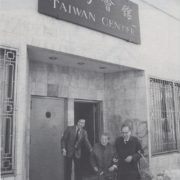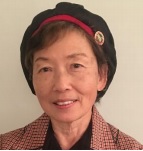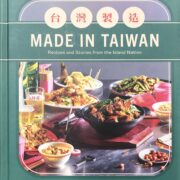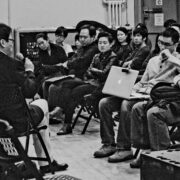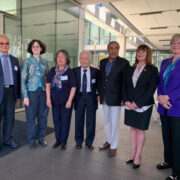New York Taiwan Center: Rebirth in the Midst of Hardship
Author: Chia-lung Cheng
I started to have a deeper understanding of the Taiwan Center when in March of 1992, I volunteered as an activity planner for senior citizens. I drafted an application for the Taiwan Center to receive regular funds from the New York City government and began to collect information about the operation of the Taiwan Center and the activities of the Evergreen Association. Because of this contact, the chairman, Dr. Lung-Fong Chen, knew about my background in social work and invited me to take on the long-vacant role of Director of the Taiwan Center. Those who were familiar with the Center’s situation were all discouraged from considering the position, since in 1991, everyone believed that even with thousands of people supporting the Center’s fundraising event, there would still be no way to resolve the Taiwan Center’s financial crisis.
But after I completed the application for the senior citizens activity fund, I also wrote up a brief operation plan for the center, and collaborated with four ambitious individuals who were still working hard to raise funds and ensure the survival of the Center: Lung-Fong Chen, Fon-may Fan, Patrick Huang, and Hong Tien Lai. They made their reports and we exchanged opinions with one another, and it was in this manner that I was initiated into my role as Center Director.
In September of 1992, I began my new term, but the debt of the Taiwan Center was not something that I, as the new director, was able to resolve. The first time I received the monthly statement from the bank, the amount in the account was just enough to pay for one month’s utility bills, with just a small remainder left. Standing alone, facing the empty lobby, it suddenly dawned upon me just how long the road ahead was. But this also inspired me, and I was determined to give the Taiwan Center a brand-new face within three or four years.
Though the Taiwan Center was only six years old in 1992, it was apparent that the building itself was already very old. The Center was also only being used to host weekly meetings, like those held by the Evergreen Association on Wednesdays, the Senior Citizen Association of Taiwanese Christians on Fridays, and the Tai-An Christian Church on Sundays. Occasionally an organization would host an event at the Center on Saturdays. It could be said that, at the time, the Taiwan Center was in a semi-stagnant state.
It was like the old saying, “if a temple does not have any elders or babies, no incense will be lit.” Though the economy at the time was sluggish and government budgets were being cut at all levels, the situation was made even more difficult by the fact that the Center had to rely upon donations from individual members and companies, as well as US government subsidies in order to keep the Center in operation. But I believed that the most important step would be to revitalize the Center, since its popularity was of the utmost importance. As a result, the senior activities were extended to five days a week. Additionally, we reached out to individuals in the community who were either unfamiliar with or had attached certain political labels to our Center and strove to show them that the Taiwan Center represents the kindness of the Taiwanese people, and we have always embraced an atmosphere of freedom.
Once we revived the spirit of the Center, it became the place of many positive interactions. The elders who had long attended activities at the Center not only became healthier, they also became enthusiastic volunteers. After this, the number of organizations that used the Center to host their events increased significantly, and people and organizations who previously misunderstand the Taiwan Center began to be relieved of their concerns. The Taiwan Center not only serves the needs of the overseas Taiwanese, it has also become a community center, and thus it has been much more integrated into the local community.
In 1995, the Center was used for over 500 activities. The events held at the Taiwan Center include 14 cultural activities, 8 Taiwanese Forums, 13 organization events, 66 religious events, 84 classes of various kinds (Yoga, Kendo, dance, flower arranging, vocational training for travel guides, and Chinese language classes), 11 health panels, 7 lifestyle lectures, 7 concerts, 32 parties and singing competitions, and 279 classes and activities for the elderly. The types of activities hosted at the Center are very diverse. Groups of other ethnicities, such as Hispanic, Korean, and Indian organizations also use the Center to host their events. After all, the Center is located in a very diverse, multi-ethnic community, and we do not wish to be confined to our own small world. Moreover, being able to provide our extra space to other ethnic groups allows us to demonstrate how proud we are to have our very own community center.
In addition to the activities of the Taiwan Center, we are actively striving to let other ethnic groups know that we are also a part of the community. For example, the historic Flushing Armory just next door to the Taiwan Center, which is currently being used by the Queens Police, was once almost turned back into a homeless shelter. At that time, we and the Seventh District Community Committee invited the Deputy Mayor of the City to come to the Taiwan Center so that members from various ethnic groups of the Flushing community could express their opinions about the organization of homeless shelters in the area and the best use for the Flushing Armory.
Supplying information and opportunities for people to better understand Taiwan is another service that the Taiwan Center provides to the community. In September of 1995, the first “Taiwan Cultural Night” was held at Lincoln Center, and the Taiwan Center’s staff helped with much of the behind-the-scenes work for the “Taiwan Joins the U.N. Campaign Committee.” Perhaps the attendees merely experienced a musical concert, but from personal experience I know that the amount of effort invested into the event was extremely high. I am confident that the Taiwan Center workers who served alongside me also uphold this belief. In our celebration of the Taiwan Center’s 10th Anniversary, we can see all the more clearly that this is true.
As the Taiwanese saying goes, “if you’re willing to be an ox, don’t worry that there won’t be a plow.” I believe that if the plow that you pull is a meaningful one, then in the future it will become a beautiful memory.

Taiwan Center Main Entrance
Excerpt from the New York Taiwan Center Tenth Anniversary Special Issue/1996/07
Translated from 27. 紐約台灣會館: 在困境中更新/鄭家隆/2014/09

